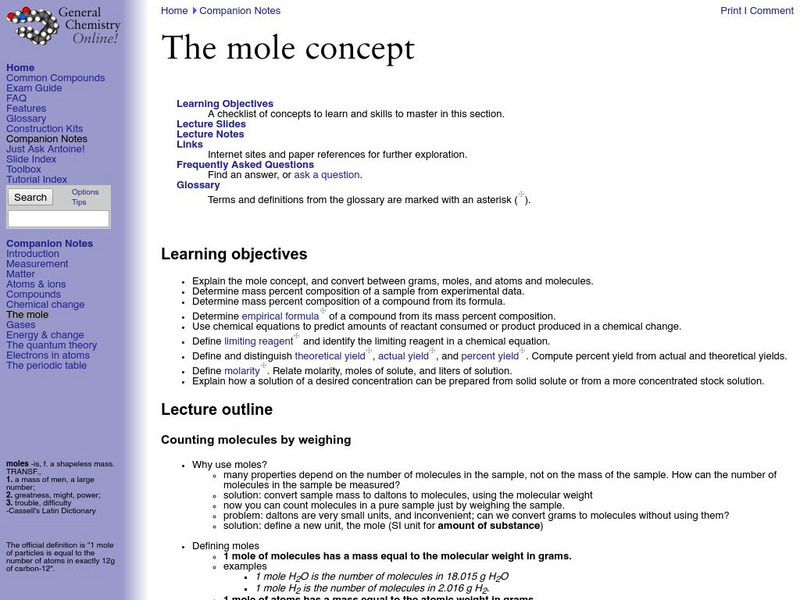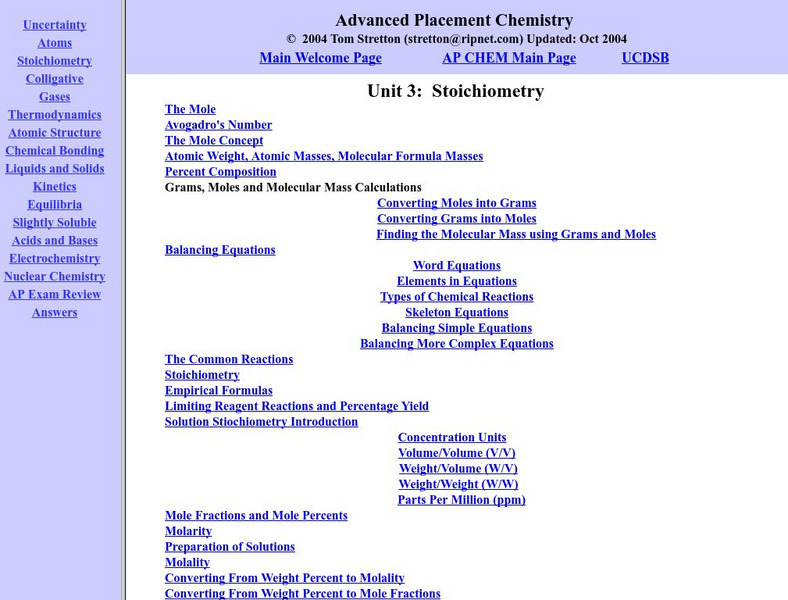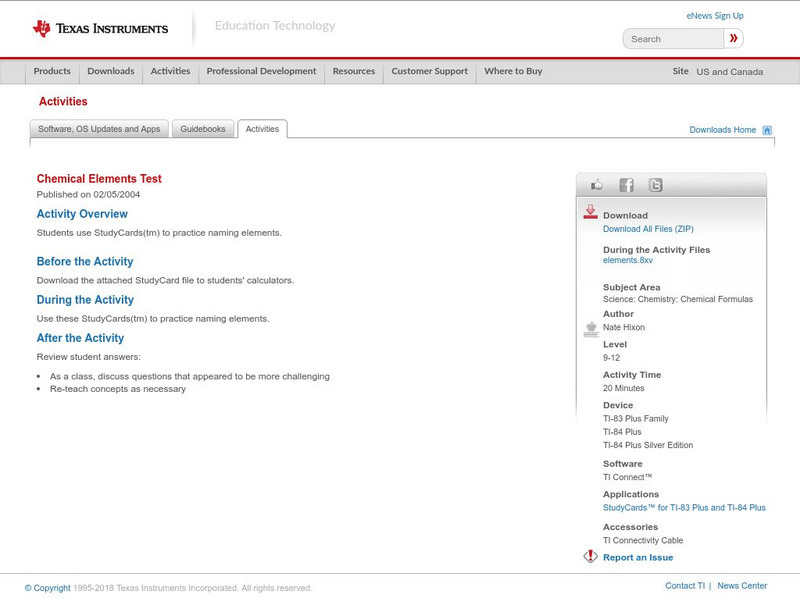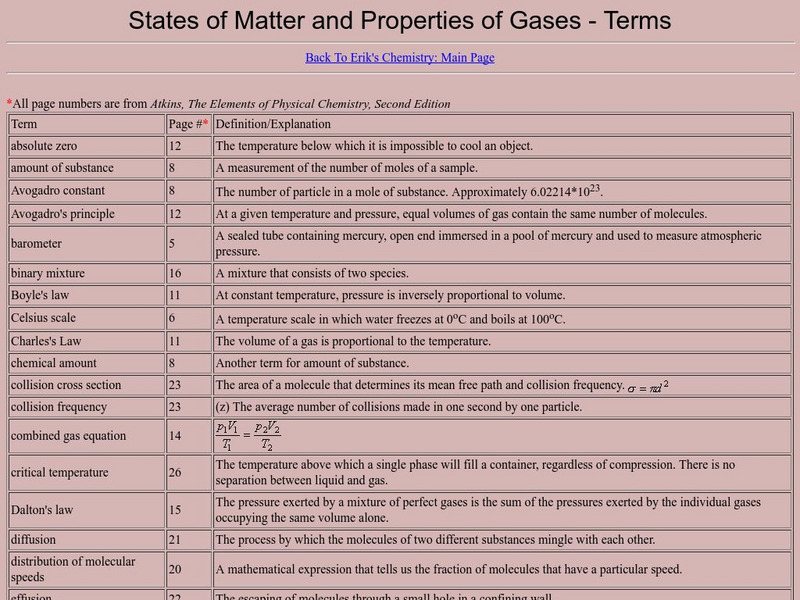Hi, what do you want to do?
Amethyst Galleries
Amethyst Galleries: Mineral Gallery: The Mineral Calcite
The world's most common mineral, Calcite, has many uses and varieties. This website lists the physical characteristics of Calcite and includes color images.
Frostburg State University
General Chemistry Online: Faq the Mole Concept
This FAQ site over general chemistry concepts presents the question: "Why are moles used?" It explains what moles are and how they can be used to count molecules and how grams can be turned into moles.
Museum of Science
The Atom's Family: Mighty Molecules
In this activity, students construct models of molecules using marshmallows and gum drops.
Curated OER
Chemical Formula of a Nucleotide
Tutorial provides an overview of the structural features of carbohydrates, lipids, proteins, and nucleic acids.
BiologyWise
Biology Wise: What Are Nitrogen Fixing Bacteria
Describes symbiotic relationship between leguminous plants and nitrogen-fixing bacteria. Explains the mechanism the bacteria use to fix nitrogen, the chemical formula involved, and different types of nitrogen-fixing bacteria.
Chem Tutor
Chem Tutor: Basic Stiochiometry
Detailed discussion of stoichiometry, mols, and percents. Includes examples showing dimensional analysis (factor-lable method) and a link to the mole road map (a diagram which leads one through the stoichiometric problem-solving process).
Upper Canada District School Board
Tom Stretton's Advanced Placement Chemistry: Stoichiometry
This online textbook chapter provides learners with advanced-level reading and practice material on stoichiometry
Upper Canada District School Board
Tom Stretton's Advanced Placement Chemistry: Atoms, Molecules and Ions
This online textbook chapter provides learners with advanced-level material on the structure and relationships between atoms, molecules and ions.
Frostburg State University
General Chemistry Online: Lipstick Chemistry
This site from Frostburg State University answers a dye relevant question and in doing so gives the structural formula of a common dye. It explains how lipstick color lasts, and what chemical produces the red color.
Upper Canada District School Board
Tom Stretton's Chemistry Pages: The Mole Concept
Deepen your understanding of the mole in chemistry. Find out the origin of the term, and the formulas it represents.
Texas Instruments
Texas Instruments: Elements Test 123
Students use StudyCards to practice naming elements.
Mocomi & Anibrain Digital Technologies
Mocomi: Alcohols, Phenols and Ethers
Find out about alcohols, phenols, and ethers, their formulas, and their uses.
Other
Organic Chemistry: Lewis/kekule Structures
This slide presentation contains a few slides that will be useful for students learning to write Lewis structures. A discussion of multiple bonds is included, and clear examples are shown.
Royal Society of Chemistry
Royal Society of Chemistry: Gridlocks: Level 2
A collection of grid puzzles that cover a wide variety of topics in intermediate high school chemistry. These are excellent for topic review and reinforcement. The puzzles can be played online and also downloaded as worksheets. Answers...
University of California
Organic Chemistry Page: A Brief Tutorial on Drawing Lewis Dot Structures
An excellent lesson on writing Lewis structures. Examples shown include ammonium ion, carbon dioxide and the carbonate ion.
Utah Education Network
Uen: Forming Ionic Compounds
Students will practice making and recording observations about various compounds and their aqueous solutions, write the formulas for the compounds, then perform chemical reactions and write the names and formulas of the products.
Chiral Publishing
Chiral Publishing: An Introduction to Chemistry: Important Substances in Food: Audio Book
Learn about the chemical compounds in the foods that you eat everyday. By viewing this audio book, you'll see many structural formulas of these compounds. Also find links to other chapters in the online textbook, animations, and power...
Texas Education Agency
Texas Gateway: Covalent Bonding: Electron Dot Diagrams
Given descriptions, diagrams, scenarios, or chemical symbols, students will model covalent bonds using electron dot formula (Lewis structures).
Web Elements
Web Elements Periodic Table: Chlorine
An excellent source of basic data, chemical and physical properties and electron dot formula information on this element.
CK-12 Foundation
Ck 12: Flex Book Textbooks: Chemistry Second Edition
[Free Registration/Login may be required to access all resource tools.] A complete, web-based, multi-media textbook covering a wide variety of Chemistry concepts.
Towson University
Towson University: Drawing Lewis Structures
Brief rules for writing Lewis structures for simple compounds. Some examples are included.
Chem Tutor
Chem Tutor: Chemistry: Lewis Structures of the Elements
This colorful page goes over the proper techniques for writing Lewis structures for elements. This is a great place to begin learning how to write Lewis structures. When you are ready for a more advanced lesson, follow the link to learn...
BiologyWise
Biology Wise: Step by Step Guide to the Process of Photosynthesis
Explains the different steps involved in photosynthesis, the formula for the chemical reaction taking place, and why photosynthesis is so important to all forms of life on Earth.
Other
States of Matter and Properties of Gases: Terms
A very complete list of terms that are important to the study of gases. This resource is a web archive.
Other popular searches
- Writing Chemical Formulas
- Naming Chemical Formulas
- Ionic Chemical Formulas
- Balancing Chemical Formulas
- Balanced Chemical Formulas
- Wrriting Chemical Formulas
- Chemical Formulas Worksheets




















